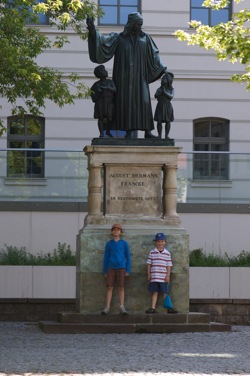At Home in Halle
Halle is a familiar place in the imaginations of those who love German Pietism. It is a place where teachers formed future pastors. It is a place where children found new life. It is a place where poverty met food, fellowship, and… Francke.
While Halle may not be a first stop for global travelers, it should be. Halle is a humble city, yet within its walls are great treasures. Our family visited Halle in May 2009. Aided by funds from an Association of Theological Schools research grant, I went to do some work in the Pietist archives. The archives are housed within the Francke Foundations and staffed by gracious and helpful librarians. One can pull texts in German and English off the shelves or order 17th century letters from Philipp Jakob Spener to August Hermann Francke, and tackle these with gloves and an eye for old German script. My German is rusty, but even simply holding correspondence detailing the lives of our Pietist forbears had meaning beyond translation. I became keenly aware that they were real people who left personal traces in service of the faith.
Much can be said about the virtues of Halle. First, of course, is the aforementioned Francke Foundations. Within these restored buildings, one can visit the old orphanage, the music and lecture hall, a museum filled with cultural artifacts, a Montessori school, and an intergenerational home. Recently restored after the atrophies of post-war occupation, the Foundations are made up of buildings that represent work of mercy and justice over the last 300 years.
A few blocks away, we visited Francke’s first post in Halle—St. George’s Church. We worshipped there with a thriving Free Church and were welcomed heartily. Halle is the home of many other beautiful churches—Methodist, Catholic, Lutheran, and others—all worth a visit!
Halle also has many natural beauties. It is situated along the river Saale. There are trails to hike along and many parks along the river. We rented a tiny motor boat that seats four. Trolling down the Saale, we passed by Halle natives engaged in a variety of activities—a pleasurable way to observe Halle’s citizens at their leisure.

The Clifton-Soderstrom children pose with Francke.
Halle offers many joys for the interested traveler. This is especially true for those who love Pietism and have a yearning to walk the streets where Francke did so much to bring about reform. However, like our Pietistic roots, Halle’s roots extend deeper. Halle is a place where one can meet our forebear Luther, as the city is within driving distance from Luther’s place of birth, death, ordination, and teaching.
In good Lutheran form, Halle is a city where the word goes to work. And it doesn’t end in Halle. One August summer night, our children and their friends gathered in our living room to watch the latest Luther film. Given that the adults included a Covenant pastor (Yak Johnson), a Covenant theologian (myself), and a Covenant philosopher (my husband Karl, who wrote his dissertation on Luther), it would be reasonable to think that we adults had chosen this historically edifying film, to force our kids to learn something about church history when they would rather be playing the Great Chase outdoors.
But that could not be farther from the truth. In fact, it was the adults who were a little hesitant about showing a film about a man who defied authorities, disobeyed his superiors, and talked to the devil. It was the adults who thought these kids, who ranged in age from six to twelve, might still be a little young to watch such a historically sophisticated film. Nevertheless, the children were insistent. After visiting Halle, Erfurt and Eisleben, Hannah, our oldest, insisted that Luther’s life was a story worth knowing.
Before we started, Karl—my husband—stood the kids on a timeline. Emmett Peterson was first, proudly standing as Jesus at the head of the line. Next came Gabe Johnson, a Celtic-looking St. Augustine. In the middle, our youngest, Johann, stood as Martin Luther. After him came our daughter Hannah, who marked the Pietist writer and lay theologian Johanna Eleonora Petersen. Penultimate was Zachary Lee playing the beloved P. P. Waldenström. The rest of us in the room played the church. As the children stood in line, Karl sequentially turned them toward Emmett, our Lord and Savior. One by one, he showed them how each of these great figures in the history of the church sought to know Jesus Christ as best they could. One by one, as they turned toward Jesus, their search was aided, in part, by what came before them—Luther by Augustine and Johanna Eleonora by Luther. This simple visual—along with the kids enthusiastic participation with one another—framed the story they were about to hear by connecting them, in the year 2009, with a man who loved Jesus over 500 years ago.
This was the effect that Halle had on my children and their friends. Halle is a place for young and old, families and groups. Halle is a draw for those who claim Pietism, those who love Luther, and those who desire to walk in the footsteps of great reformers of the Christian church. And perhaps most especially, Halle is a place you can bring home!
